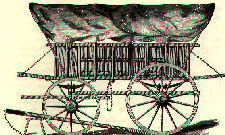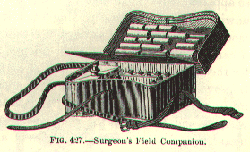December 01, 2001
Health Department
![]()
![]()
- calomel (1676) : a white tasteless compound Hg 2 Cl 2 used esp. as a fungicide and insecticide and occas. in medicine as a purgative; also called mercurous chloride.
- Among important compounds of antimony are tartar emetic, a double tartrate of antimony and potassium used as a medicinal agent and butter of antimony, antimony trichloride, used for bronzing steel, as a mordant in dyeing, and as a caustic in medicine.
- senna-tea - any of a genus ( Cassia ) of leguminous herbs, shrubs, and trees native to warm regions; used medicinally.
![]()
- 16 drams (drachms) = 1 ounce.
- quassia: A drug from the heartwood of various tropical trees of the ailanthus family, used as a bitter tonic and remedy for roundworms in children and as an insecticide.
![]()
Archibald Atkinson, Jr served as a
doctor in the Confederate Army. This
first-hand account is, from his
perspective, the chronicle of his
military career. Most of the
transcription, courtesy of Virginia
Tech, is in tact from the original
manuscript. For now, I have only
included those parts that pertain to
medicine and rations.
What separates this narrative from others is his candid, and sometimes sharp, remarks about several
Conferderate officers. Although incomplete and inconsistent as to timeframe, it lends much insight about
rations, medicine, battles and, to some extent, civilian life.

...I had the Vaughan Hotel for my hospital, normally a cavalry hospital for the sick of the Wise legion, but I never turned any sick man off. The house was in a large meadow and as a cavalry man came in his horse would be turned into this meadow where besides an abundance of good grass there was plenty of water. I had about 500 sick and convalescent soldiers, cavalry, infantry and artillery of all the commanders in that section.
There was an epidemic of measles in the army and every soldier who had not been 10 miles from his home before he enlisted was seized with it. I've had boys of 16, and fathers of 60 years lying side by side on straw beds placed on the floor all suffering from measles or some of its complications. We had the poorest commissary arrangements, and all I could get for my men was salt and hard crackers. I made the convalescents shoot squirrels, ground hogs, pheasants, and turkeys with which to make soup for the men. I don't know how poor fellows fared who were sick in camp. I made all sorts of soups and stews for the men.
The nights were as cold as in Jan. for we were high up the mountain, and had to have fires all the time. One night about 10 o'clock in a pouring rain the infantry came marching by the hospital. There were ambulances all laden with tents and trunks (for early in the war officers attempted to carry trunks) then came artillery and the rattling over the corduroy road was fearful. No one would or could tell us any thing as to why they were vacating so suddenly.
 I had never seen an army terror stricken before, and though I could not see the men for the rain and darkness, I knew their hearts were in their throats.
I had never seen an army terror stricken before, and though I could not see the men for the rain and darkness, I knew their hearts were in their throats.
Surgeon’s Field Companion from The Medical and Surgical History of the War of the Rebellion (1861-65)
... I had over 400 sick men in the hospital and in the sheds and barns around the premises and I did not wish them to be captured but I made up my mind if this had to result from the mismanagement of those in command I would remain with them...
... I remember one especially hot day in May when as we were marching, men dropped like sheep along the road, while others were just able to drag their weary feet: poor half starved creatures trying to fight upon food hardly fit to sustain life, whilst those they opposed were not only more numerous but got their full quota of sleep, rest, rations, condensed milk, the best soup (which the French say makes the soldier) and frequently big dinners before battle. The Yankees had men enough and to spare, enough to relieve guard, to allow for straggling on such a day as May 12th. Who if they were foot sore and leg weary could be allowed to ride in ambulances. Men enough to spare half, and yet have more than the Confederate line opposing them had. Our men were broken down and half starved...
... On Sewell Mt. one of the men of the Wise Legion fired as he supposed on the enemy, and the load went into the mouth of a Mr. Romaine of Capt. Phelp's Co. I kept the old man in the command, and we took him in a buggy for 6 weeks. His tongue and cheeks and lower jaw were shot all to pieces. I kept him fed by the bowel with gruel, soups, egg and whiskey. He did well and in 6 months his tongue had healed and he could talk fairly well.
There was a dearth of every thing except bullets, smoke and suffering. There was a sort of improvised bush hospital gotten up by Dr. Grimes and myself, but we could not even get our ambulance wagons to bring us supplies for operating and dressing wounds. Maj. Jno. W. Daniel of Lynchburg then Gen. Early's adjutant Gen. was brought with his right thigh bone fractured. We examined him and the consensus of opinion was that to save his life he should lose his thigh high up. Dr. Grimes and I fought against it contending that for a man to lose his thigh at that point even if he recovered his life would be a burden. We gained our point and finding the bone very much shattered we enlarged the bullet wound sufficiently to pick out all loose bits of crushed bones and rounded up the pointed ends of the fractured parts, and he recovered finally the use of his leg. I saved a good many limbs and all did well as far as I know.
... We were camping near Hedgersville and in the middle of the night came an order to the 10th Va. cavalry to furnish 6 days rations to a certain number of men from each company, and to have the horses in good trim for the next day. Col. Davis sent for me and said he would like for me to go with them. There was a man always detailed to accompany me to carry the knapsack containing bandages, pocket case of instruments, and a small amputating case.
In cavalry we could do less for our wounded than in infantry, for the cavalry troops are the eyes and ears for the army, and we usually on the move. We stayed near H-[headquarters] until the order came to move quietly down the mountain to within a mile of the Potomac river. We were then told to take saddles off the horses and rest and feed them, for we had each corn and oats with us...
... In cavalry we were on the go all the time, in front of our army, or way behind it. We would be ordered 4 or 6 days rations, and off we would go. Nothing melts like rations. I would frequently eat all I could, and give away the surplus, trusting to luck for the next days meals, rather than carry food packed in my haversack, or dragging on my shoulder strap. Then too I wanted the haversack for horse feed. It held nearly a gallon and whenever we stopped to clear the road or to wait for wagons or artillery to pass on I would feed my horse. He was my dependence and my companion...
![]()
[Photograph (1864) of the Dictator, a deadly but inaccurate 13-inch mortar, from the main eastern theater of war, the siege of Petersburg, June 1864-April 1865. Its major disadvantage was its size, which made transportation difficult. From the LC Civil War collection.]
![[The Dictator Cannon]](TheDictatorCannon.gif) "In the Field" contains accurate information for reenactors, both military and civilian, and historic researchers. Contents will change frequently and focus on authentic "Recipes " appropriate for the field, well-researched information for "The Field Doctor," "Portraits of War," proper military attire and "Links" to additional beneficial civil war web sites.
"In the Field" contains accurate information for reenactors, both military and civilian, and historic researchers. Contents will change frequently and focus on authentic "Recipes " appropriate for the field, well-researched information for "The Field Doctor," "Portraits of War," proper military attire and "Links" to additional beneficial civil war web sites.
![]()
![[Soldiers’ Rest]](AlexCooks.gif) Discover your culinary delights with Civil War Recipes for Any Occasion! This page is packed with recipes and updated frequently. Many are suitable for Living History Events. [Photograph of Alexandria, Va. Cooks in the kitchen of Soldiers' Rest. From the LC Civil War collection.]
Discover your culinary delights with Civil War Recipes for Any Occasion! This page is packed with recipes and updated frequently. Many are suitable for Living History Events. [Photograph of Alexandria, Va. Cooks in the kitchen of Soldiers' Rest. From the LC Civil War collection.]
![]()
Unearth little known facts about the US Civil War. Now Featuring: Does the Camera Ever Lie?
Want to know more about Women and the Civil War?
The Web Ring Community Provides Easy Access to American Civil War Information.